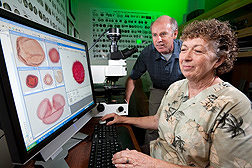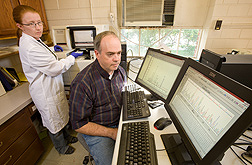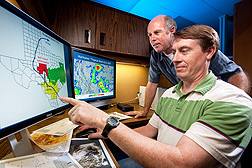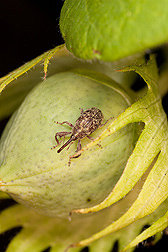Mystery Solved: Detecting the Source
of a Boll Weevil Outbreak
|
|
In late summer of 2007, cotton growers in Texas’s Southern Rolling Plains had reason to be alarmed. Hundreds of boll weevils were turning up in their fields. By the end of the year, more than 6,000 weevils were found in monitoring traps spread across several counties where the insect had been eradicated since 2000.
But a team of Agricultural Research Service scientists with a variety of skills was able to track down the likely origins of the reinfestation, giving cotton growers and entomologists some guidance on how to eradicate them and shedding light on just how far boll weevils can travel under certain conditions.
Boll weevils have been a threat to cotton growers since 1892, when they entered Texas from Mexico and proceeded to invade much of the south-central and southeastern United States. Large-scale eradication efforts, begun about 30 years ago, eliminated the boll weevil from much of the southern United States, but they remain a problem in pockets of eastern and southern Texas. Successful eradication efforts drastically reduce pest-management costs and insecticide use. Reinvasion is a constant threat, even in areas where they have been eliminated. Guarding against reinfestation is coordinated by the grower-supported Texas Boll Weevil Eradication Foundation, which funds monitoring programs and insecticide applications throughout the state.
|
|
“Whenever eradication personnel capture boll weevils where they’re not expected, they want to know everything possible about where the weevils may have come from. That information plays a major role in deciding the most appropriate response,” says Thomas Sappington, an ARS entomologist in the Corn Insects and Crop Genetics Unit in Ames, Iowa. If the infestation is small scale, eradication personnel may need to spray only a few surrounding cotton fields. But if there is evidence of a widespread reinvasion, they may have to conduct more extensive spraying.
In this case, the eradication foundation in the Southern Rolling Plains spent $1.4 million in increased insecticide applications alone, plus outlays for increased trapping, after they discovered the infestation.
Collecting the Evidence
Pinpointing the origins of the 2007 infestation took diverse skills. Sappington is an expert at using DNA to identify insect populations. Boll weevils travel on the wind, and John Westbrook, a meteorologist with the Southern Plains Agricultural Research Center (SPARC) in College Station, Texas, uses modeling techniques and weather data to analyze the effects of wind patterns on insect movement. Gretchen Jones, also based at SPARC, is a palynologist, or pollen expert, who can often identify an insect’s itinerary by the type of pollen grains it picks up.
|
|
All flowering plants release pollen, and the pollen grains have distinctive shapes. Cotton pollen has a structure that makes it a particularly good forensic tool. It clings to the face, legs, and body of a boll weevil and will remain in the insect’s gut for about 24 hours.
There are limitations to all three tracking techniques, the researchers say.Pollen analysis, for instance, involves matching grains released by plants in one location with pollen taken from mobile insects, so it can be difficult to tell at what point along an insect’s journey the pollen was picked up. Winds blow in all directions, so you have to know when weevils arrived in a specific area to say whether wind patterns from a specific storm brought them there. In population genetics, finding distinctions in DNA that set one group apart from another depends on how isolated they are from each other. When insect groups breed with each other, the gene flow can make them hard to tell apart.
The researchers had one clue. Tropical Storm Erin swept through South Texas in August 2007, passing 112 miles to the south near Uvalde in an area known as the “Winter Garden District.” Between Uvalde and the infested region is the Texas Hill Country, an arid region of scrubby vegetation with plants that produce types of pollen not found among the captured weevils.
Weevils frequently disperse in late summer and early fall when cotton is fully grown and fields are being harvested. “In those scenarios, it’s easier to detect them with traps,” says Westbrook. Some trapping studies have shown that weevils are capable of flying hundreds of miles. There were no studies that focused on exactly how far they can travel if propelled by a storm.
|
|
Sappington focused on identifying patterns in the boll weevils’ genetic makeup, comparing the DNA of 20 weevils captured in the reinfested Southern Rolling Plains zone with the DNA of dozens of weevils from 24 other sites in Texas and northern Mexico. Jones examined pollen grains found clinging to body parts and inside the guts of another 16 captured weevils, comparing them under a light microscope with pollen from plants blooming in Uvalde and in Cameron, an area east of the infested region where some officials suspected the weevils originated. Westbrook studied wind patterns and analyzed possible migration paths with help from HYSPLIT, a computer model originally designed by the National Oceanic and Atmospheric Administration for federal studies that track the movements of smoke, particulate matter, and other airborne pollution.
The researchers concluded that the weevils likely came from the Winter Garden District. Westbrook found that Tropical Storm Erin skirted the southern and western sides of the reinfested region as it passed through, generating winds for 7 days that could have brought weevils up from the Winter Garden District. Jones found pollen on the invading weevils from nine plants common in Uvalde, including ragweed. She also found that the weevils lacked pollen from any of the numerous plants abundant in Cameron samples. Sappington reached the same conclusions by studying differences in DNA stretches known as “microsatellite loci,” which can show collective patterns unique to each weevil population.
The results, published in the Journal of the Royal Society Interface, prompted growers to target the Winter Garden District for stepped-up eradication efforts. The work could also lead to better control measures. One way to prevent reinfestations is to harvest and destroy stalks early. The results of the study provide guidance on when approaching storms and hurricanes may warrant an early harvest. The multipronged approach also could be used as a model for resolving future questions about whether unexpected population spikes in fruit flies, aphids, or other pests are being caused by populations of insects from other areas.—By Dennis O'Brien, Agricultural Research Service Information Staff.
This research is part of Crop Protection and Quarantine (#304) and Crop Production (#305), two ARS national programs described at www.nps.ars.usda.gov.
To reach scientists mentioned in this article, contact Dennis O’Brien, USDA-ARS Information Staff, 5601 Sunnyside Ave., Beltsville MD 20705-5129; (301) 504-1624.
"Mystery Solved: Detecting the Source of a Boll Weevil Outbreak" was published in the January 2011 issue of Agricultural Research magazine.










